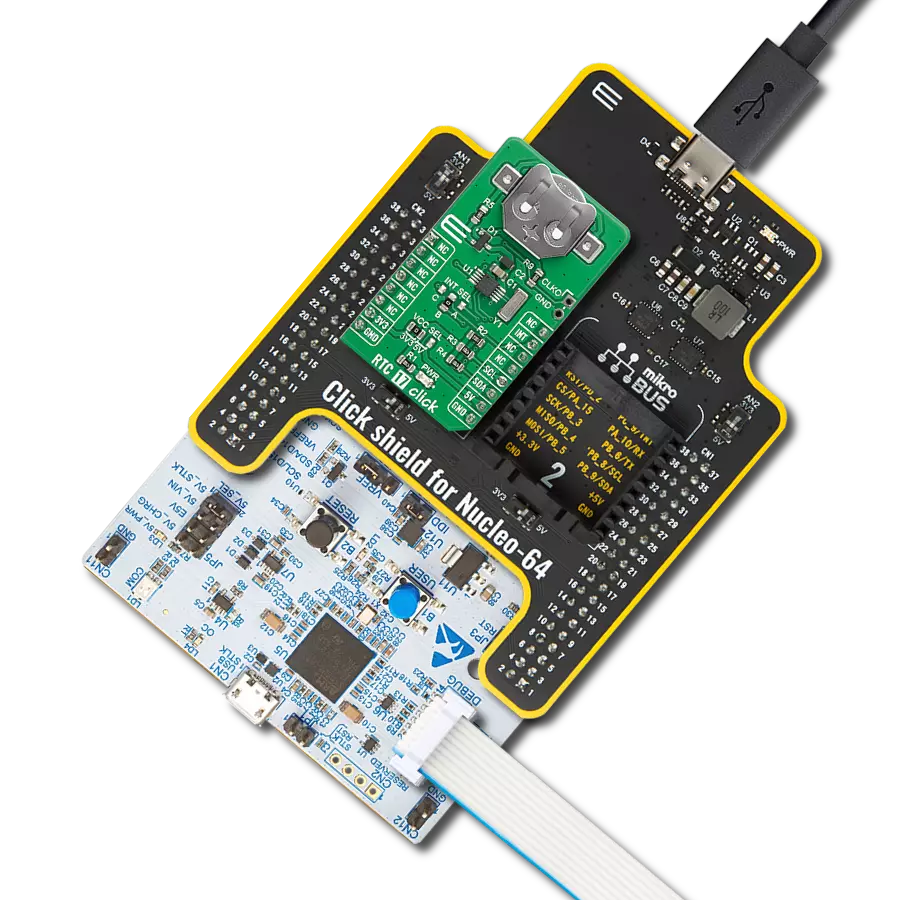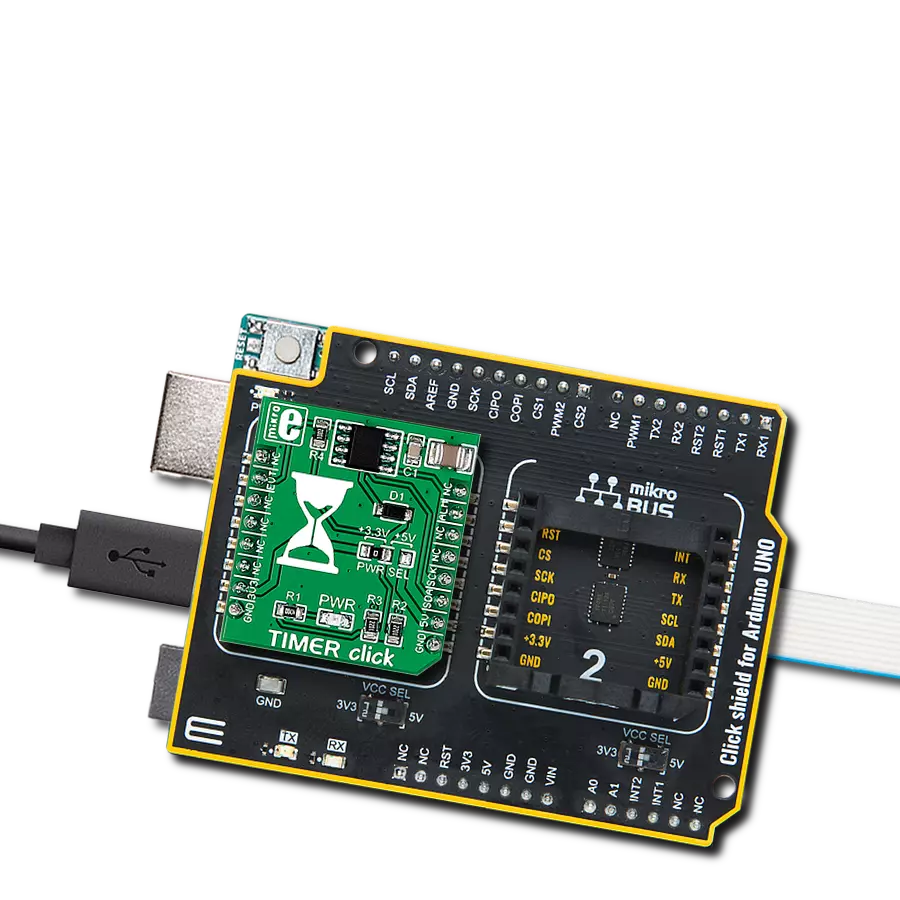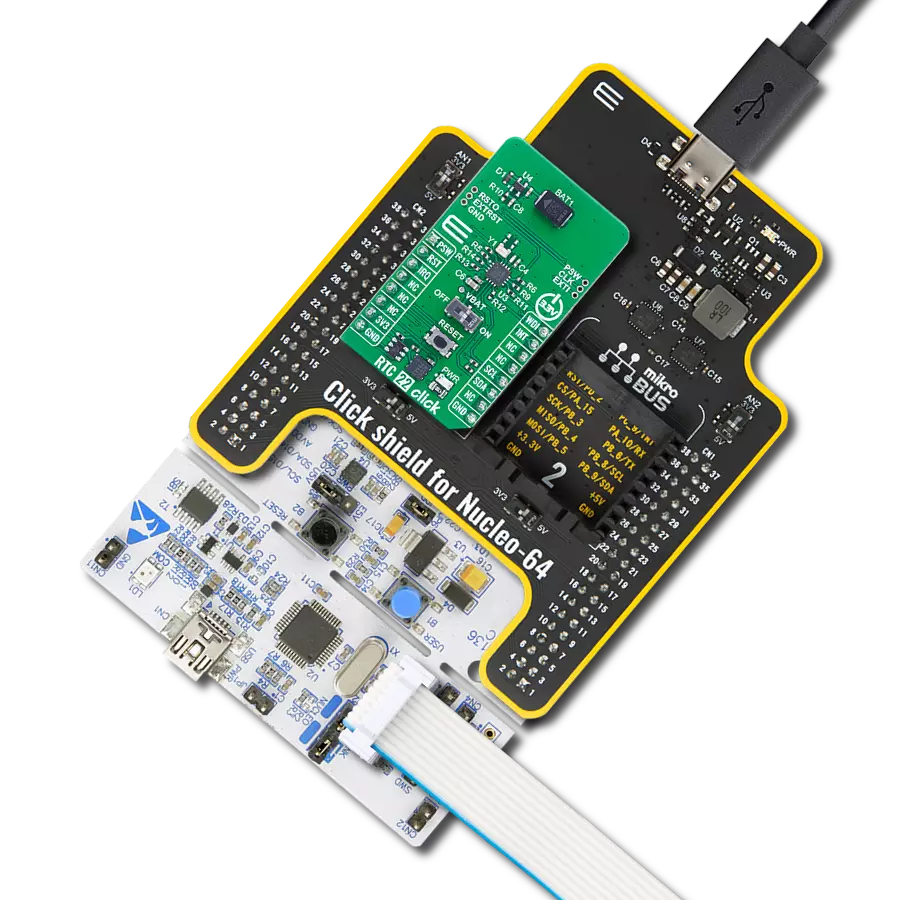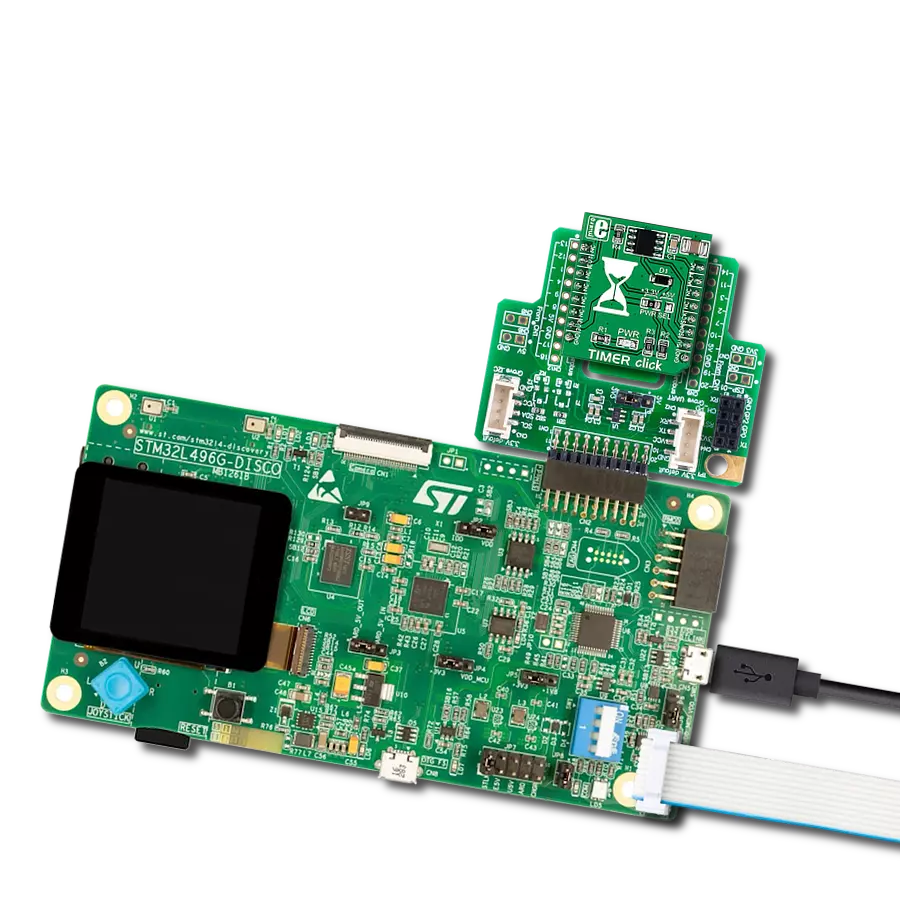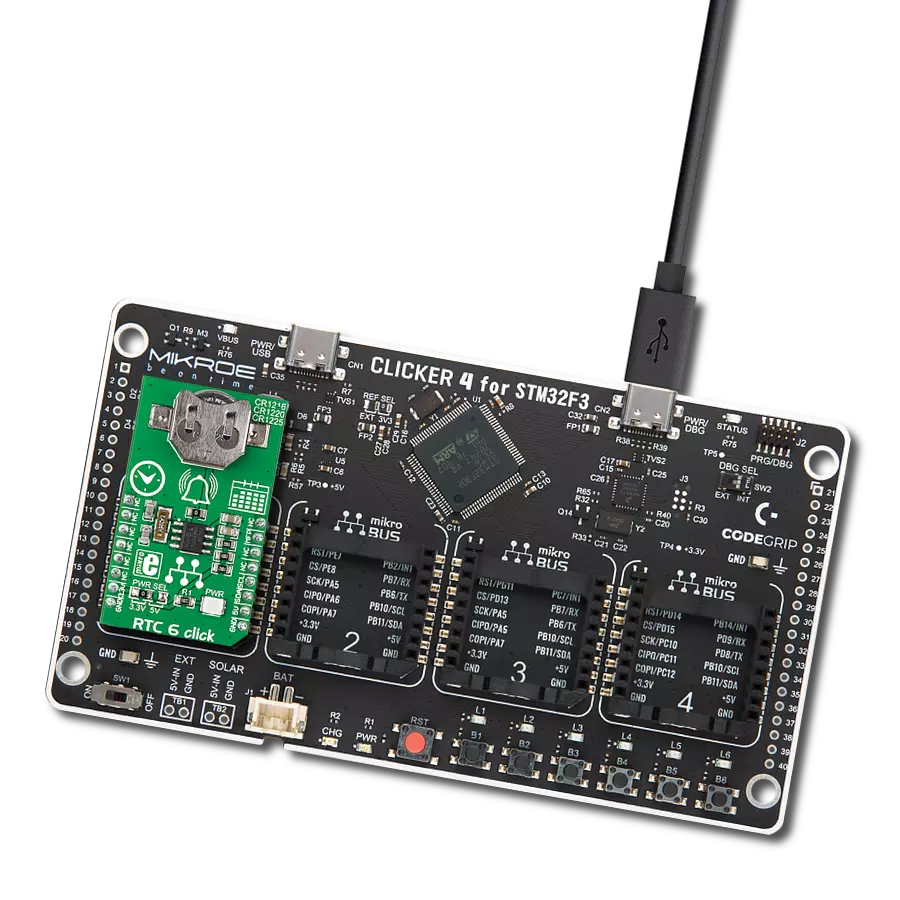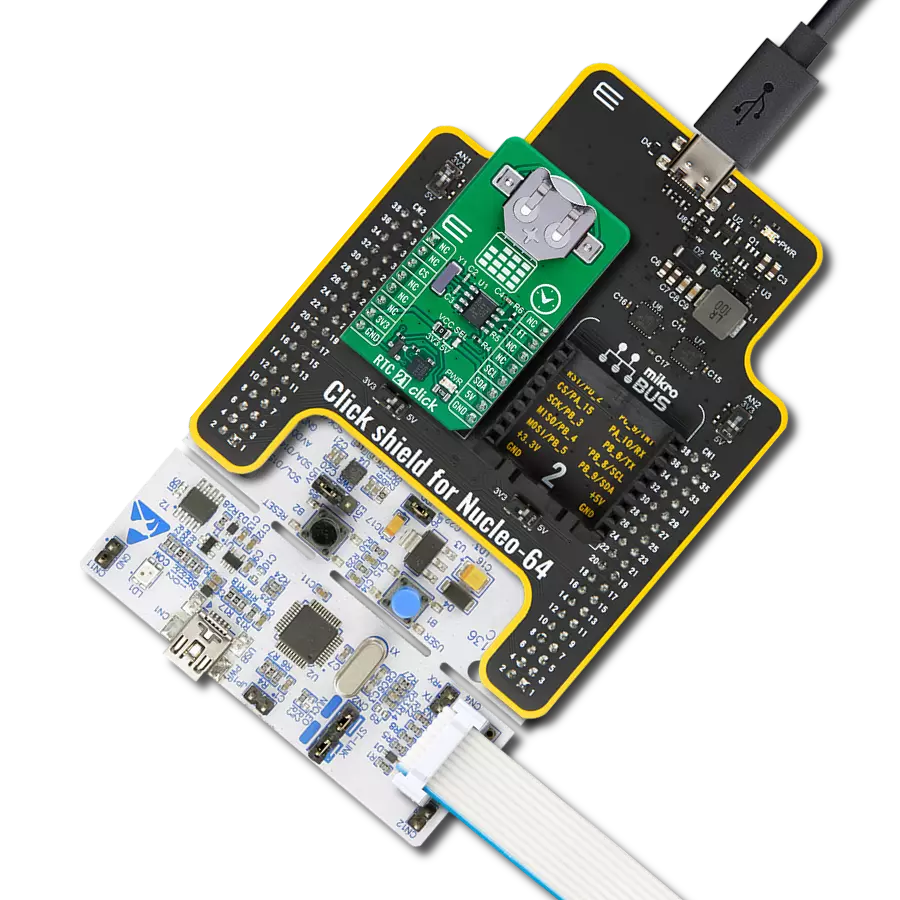Experience the precision of advanced real-time clock technology, ensuring reliable timekeeping and synchronization in your solution
A
A
Hardware Overview
How does it work?
RTC 20 Click is based on the AB0805, a low-power, real-time clock (RTC) time-keeping device from Abracon. The AB0805 is configured to transmit calendar and time data to the MCU based on a 32.768kHz quartz crystal and comes with 256 bytes of general-purpose RAM. It reads and writes clock/calendar data from and to the MCU in units ranging from seconds to the last two digits of the calendar year, providing seconds, minutes, hours, dates, days, weeks, months, years, and century information. The end-of-the-month date is automatically adjusted for months with fewer than 31 days, including corrections for the leap year until 2199. This Click board™
communicates with the MCU using the standard I2C 2-Wire interface to read data and configure settings, supporting a Fast Mode operation up to 400kHz. By utilizing an automatic backup switch feature, this RTC can use an external power source (220mF supercapacitor) when there is no power supply on its main power terminals, thus allowing for uninterrupted operation. Besides an automatic backup switchover circuit, the AB0805 has flexible inputs that aggregate various interrupt sources to an MCU. Based on this, functions like external interrupt or watchdog timer reset could be found on this Click board™ routed on the EXT and WDI pins of the mikroBUS™ socket, as well as the
primary and secondary interrupt signals routed on the IR1 and IR2 pins of the mikroBUS™ socket. In addition to the alarm/interrupt feature, the IR1 signal also provides the selectable-frequency square wave signal (512Hz default value). This Click board™ can be operated only with a 3.3V logic voltage level. The board must perform appropriate logic voltage level conversion before using MCUs with different logic levels. Also, it comes equipped with a library containing functions and an example code that can be used as a reference for further development.
Features overview
Development board
PIC18F57Q43 Curiosity Nano evaluation kit is a cutting-edge hardware platform designed to evaluate microcontrollers within the PIC18-Q43 family. Central to its design is the inclusion of the powerful PIC18F57Q43 microcontroller (MCU), offering advanced functionalities and robust performance. Key features of this evaluation kit include a yellow user LED and a responsive
mechanical user switch, providing seamless interaction and testing. The provision for a 32.768kHz crystal footprint ensures precision timing capabilities. With an onboard debugger boasting a green power and status LED, programming and debugging become intuitive and efficient. Further enhancing its utility is the Virtual serial port (CDC) and a debug GPIO channel (DGI
GPIO), offering extensive connectivity options. Powered via USB, this kit boasts an adjustable target voltage feature facilitated by the MIC5353 LDO regulator, ensuring stable operation with an output voltage ranging from 1.8V to 5.1V, with a maximum output current of 500mA, subject to ambient temperature and voltage constraints.
Microcontroller Overview
MCU Card / MCU
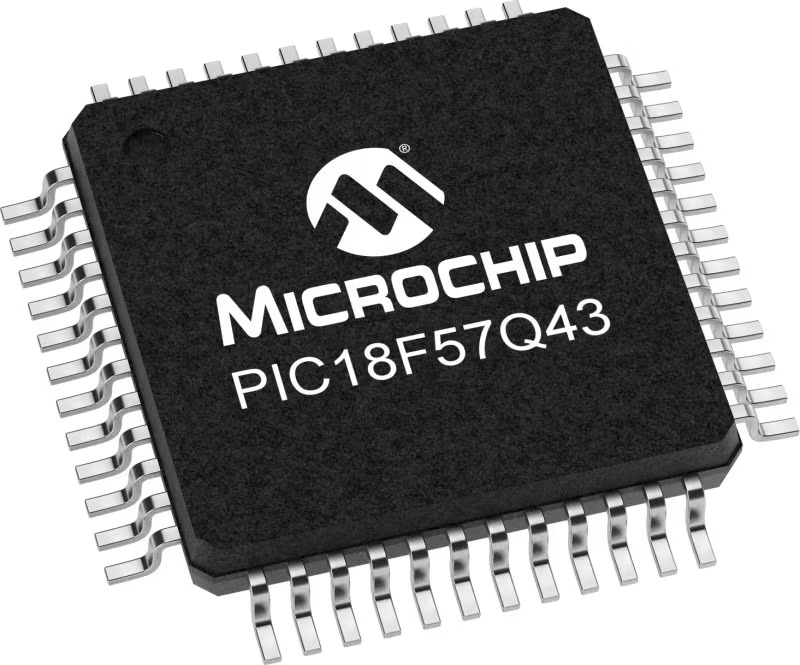
Architecture
PIC
MCU Memory (KB)
128
Silicon Vendor
Microchip
Pin count
48
RAM (Bytes)
8196
You complete me!
Accessories
Curiosity Nano Base for Click boards is a versatile hardware extension platform created to streamline the integration between Curiosity Nano kits and extension boards, tailored explicitly for the mikroBUS™-standardized Click boards and Xplained Pro extension boards. This innovative base board (shield) offers seamless connectivity and expansion possibilities, simplifying experimentation and development. Key features include USB power compatibility from the Curiosity Nano kit, alongside an alternative external power input option for enhanced flexibility. The onboard Li-Ion/LiPo charger and management circuit ensure smooth operation for battery-powered applications, simplifying usage and management. Moreover, the base incorporates a fixed 3.3V PSU dedicated to target and mikroBUS™ power rails, alongside a fixed 5.0V boost converter catering to 5V power rails of mikroBUS™ sockets, providing stable power delivery for various connected devices.
Used MCU Pins
mikroBUS™ mapper
Take a closer look
Click board™ Schematic
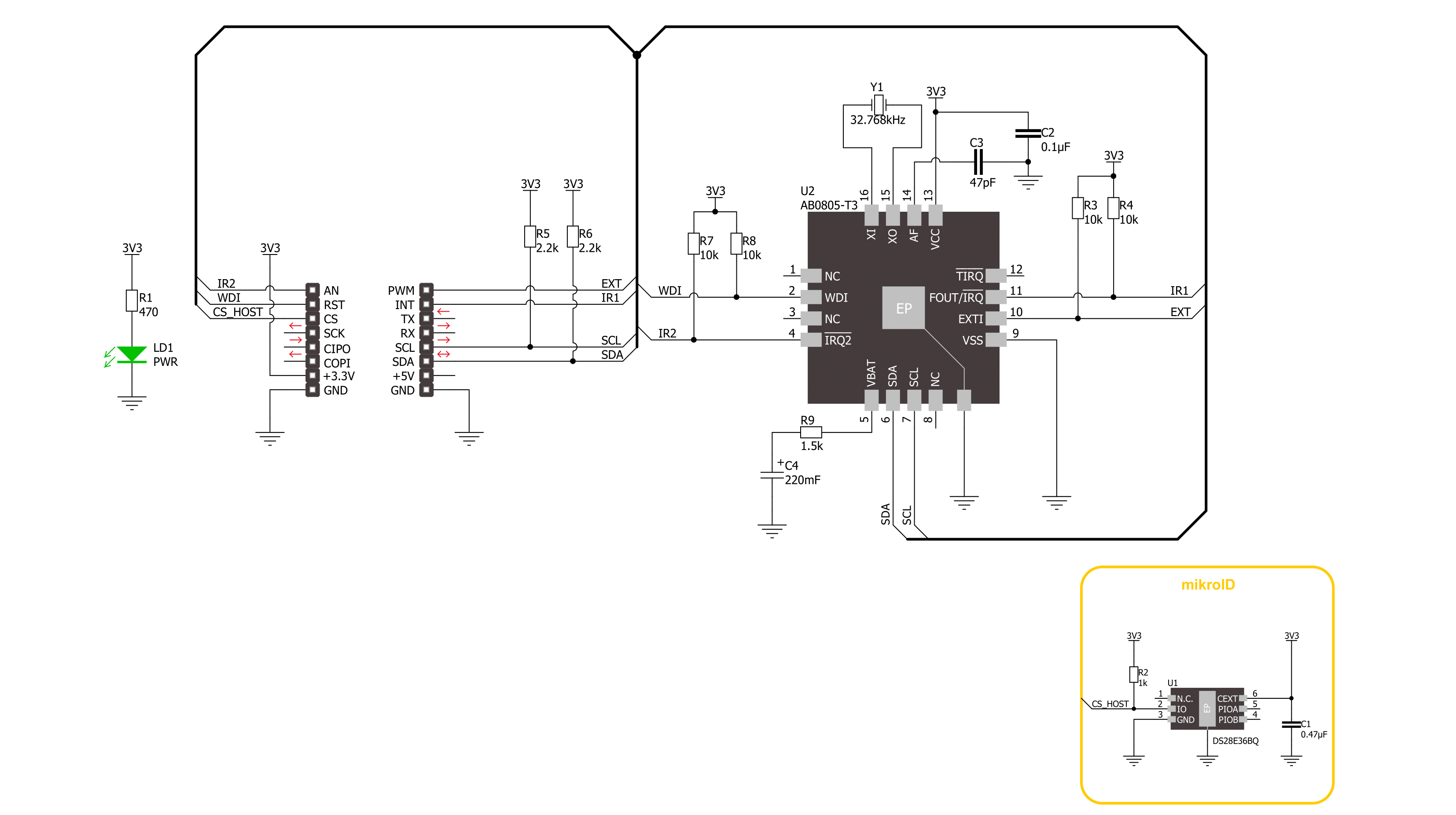
Step by step
Project assembly
Track your results in real time
Application Output
1. Application Output - In Debug mode, the 'Application Output' window enables real-time data monitoring, offering direct insight into execution results. Ensure proper data display by configuring the environment correctly using the provided tutorial.

2. UART Terminal - Use the UART Terminal to monitor data transmission via a USB to UART converter, allowing direct communication between the Click board™ and your development system. Configure the baud rate and other serial settings according to your project's requirements to ensure proper functionality. For step-by-step setup instructions, refer to the provided tutorial.

3. Plot Output - The Plot feature offers a powerful way to visualize real-time sensor data, enabling trend analysis, debugging, and comparison of multiple data points. To set it up correctly, follow the provided tutorial, which includes a step-by-step example of using the Plot feature to display Click board™ readings. To use the Plot feature in your code, use the function: plot(*insert_graph_name*, variable_name);. This is a general format, and it is up to the user to replace 'insert_graph_name' with the actual graph name and 'variable_name' with the parameter to be displayed.

Software Support
Library Description
This library contains API for RTC 20 Click driver.
Key functions:
rtc20_set_time- RTC 20 set time function.rtc20_set_date- RTC 20 set date function.rtc20_get_time- RTC 20 get time function.
Open Source
Code example
The complete application code and a ready-to-use project are available through the NECTO Studio Package Manager for direct installation in the NECTO Studio. The application code can also be found on the MIKROE GitHub account.
/*!
* @file main.c
* @brief RTC 20 Click example
*
* # Description
* This example demonstrates the use of the RTC 20 Click board™
* by reading and displaying the RTC time and date values.
*
* The demo application is composed of two sections :
*
* ## Application Init
* Initialization of I2C module, log UART and additional pins.
* After driver initialization the app set RTC time to 23:59:50
* and set date to Tuesday 28.02.2023.
*
* ## Application Task
* This is an example that shows the use of a RTC 20 Click board™.
* In this example, we read and display the current time ( PM )
* and date ( day of the week ), which we also previously set.
* Results are being sent to the Usart Terminal where you can track their changes.
* All data logs write on USB changes every 1 sec.
*
*
* @author Nenad Filipovic
*
*/
#include "board.h"
#include "log.h"
#include "rtc20.h"
static rtc20_t rtc20;
static log_t logger;
static uint8_t new_sec = 255;
static rtc20_time_t time;
static rtc20_date_t date;
/**
* @brief RTC 20 display day of week name function.
* @details This function display the name of day of the week.
*/
static void display_day_of_week ( void );
void application_init ( void )
{
log_cfg_t log_cfg; /**< Logger config object. */
rtc20_cfg_t rtc20_cfg; /**< Click config object. */
/**
* Logger initialization.
* Default baud rate: 115200
* Default log level: LOG_LEVEL_DEBUG
* @note If USB_UART_RX and USB_UART_TX
* are defined as HAL_PIN_NC, you will
* need to define them manually for log to work.
* See @b LOG_MAP_USB_UART macro definition for detailed explanation.
*/
LOG_MAP_USB_UART( log_cfg );
log_init( &logger, &log_cfg );
log_info( &logger, " Application Init " );
// Click initialization.
rtc20_cfg_setup( &rtc20_cfg );
RTC20_MAP_MIKROBUS( rtc20_cfg, MIKROBUS_1 );
if ( I2C_MASTER_ERROR == rtc20_init( &rtc20, &rtc20_cfg ) )
{
log_error( &logger, " Communication init." );
for ( ; ; );
}
time.hour = 23;
time.minute = 59;
time.second = 50;
if ( RTC20_OK == rtc20_set_time( &rtc20, time ) )
{
log_printf( &logger, " Set time : %.2d:%.2d:%.2d\r\n",
( uint16_t ) time.hour, ( uint16_t ) time.minute, ( uint16_t ) time.second );
}
date.day_of_week = RTC20_DW_TUESDAY;
date.day = 28;
date.month = 2;
date.year = 23;
if ( RTC20_OK == rtc20_set_date( &rtc20, date ) )
{
log_printf( &logger, " Set date : %.2d-%.2d-%.2d\r\n",
( uint16_t ) date.day, ( uint16_t ) date.month, ( uint16_t ) date.year );
}
Delay_ms ( 1000 );
log_printf( &logger, "---------------------\r\n" );
}
void application_task ( void )
{
if ( RTC20_OK == rtc20_get_time( &rtc20, &time ) )
{
if ( RTC20_OK == rtc20_get_date( &rtc20, &date ) )
{
if ( time.second != new_sec )
{
log_printf( &logger, " Date : %.2d-%.2d-%.2d\r\n",
( uint16_t ) date.day, ( uint16_t ) date.month, ( uint16_t ) date.year );
display_day_of_week( );
log_printf( &logger, " Time : %.2d:%.2d:%.2d\r\n",
( uint16_t ) time.hour, ( uint16_t ) time.minute, ( uint16_t ) time.second );
log_printf( &logger, "- - - - - - - - - - -\r\n" );
new_sec = time.second;
Delay_ms ( 1 );
}
}
}
Delay_ms ( 1 );
}
int main ( void )
{
/* Do not remove this line or clock might not be set correctly. */
#ifdef PREINIT_SUPPORTED
preinit();
#endif
application_init( );
for ( ; ; )
{
application_task( );
}
return 0;
}
static void display_day_of_week ( void )
{
switch ( date.day_of_week )
{
case RTC20_DW_SUNDAY:
{
log_printf( &logger, "Sunday\r\n" );
break;
}
case RTC20_DW_MONDAY:
{
log_printf( &logger, "Monday\r\n" );
break;
}
case RTC20_DW_TUESDAY:
{
log_printf( &logger, "Tuesday\r\n" );
break;
}
case RTC20_DW_WEDNESDAY:
{
log_printf( &logger, "Wednesday\r\n" );
break;
}
case RTC20_DW_THURSDAY:
{
log_printf( &logger, "Thursday\r\n" );
break;
}
case RTC20_DW_FRIDAY:
{
log_printf( &logger, "Friday\r\n" );
break;
}
case RTC20_DW_SATURDAY:
{
log_printf( &logger, "Saturday\r\n" );
break;
}
default:
{
log_printf( &logger, "Unknown\r\n" );
}
}
}
// ------------------------------------------------------------------------ END
Additional Support
Resources
Category:RTC





















